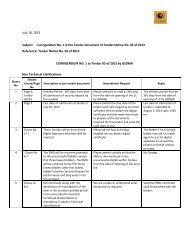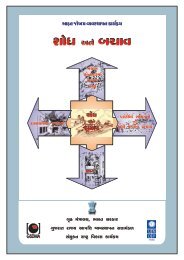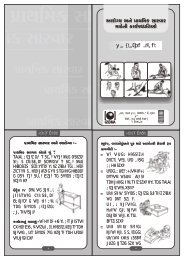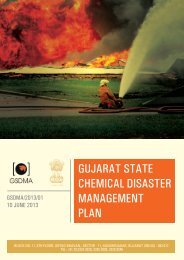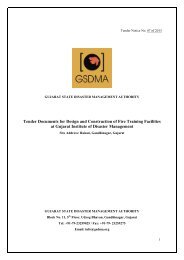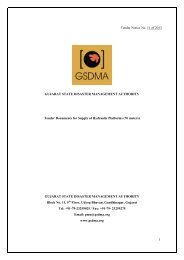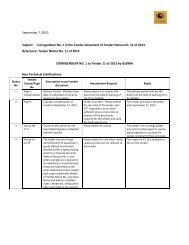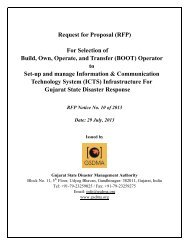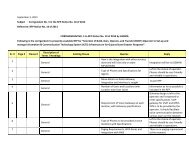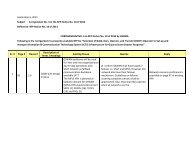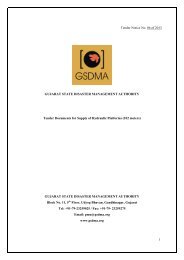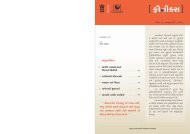Emergency Response Guidebook - Gujarat State Disaster ...
Emergency Response Guidebook - Gujarat State Disaster ...
Emergency Response Guidebook - Gujarat State Disaster ...
Create successful ePaper yourself
Turn your PDF publications into a flip-book with our unique Google optimized e-Paper software.
GUIDE114Explosives* - Division 1.4 or 1.6 ERG2012ERG2012Explosives* - Division 1.4 or 1.6GUIDE114POTENTIAL HAZARDSFIRE OR EXPLOSION• MAY EXPLODE AND THROW FRAGMENTS 500 meters (1/3 MILE) OR MORE IF FIRE REACHES CARGO.• For information on “Compatibility Group” letters, refer to Glossary section.HEALTH• Fire may produce irritating, corrosive and/or toxic gases.PUBLIC SAFETY• CALL EMERGENCY RESPONSE Telephone Number on Shipping Paper first. If Shipping Paper notavailable or no answer, refer to appropriate telephone number listed on the inside back cover.• Isolate spill or leak area immediately for at least 100 meters (330 feet) in all directions.• Move people out of line of sight of the scene and away from windows.• Keep unauthorized personnel away.• Stay upwind.• Ventilate closed spaces before entering.PROTECTIVE CLOTHING• Wear positive pressure self-contained breathing apparatus (SCBA).• Structural firefighters’ protective clothing will only provide limited protection.EVACUATIONLarge Spill• Consider initial EVACUATION for 250 meters (800 feet) in all directions.Fire• If rail car or trailer is involved in a fire, ISOLATE for 500 meters (1/3 mile) in all directions; also initiateevacuation including emergency responders for 500 meters (1/3 mile) in all directions.EMERGENCY RESPONSEFIRECARGO Fire• DO NOT fight fire when fire reaches cargo! Cargo may EXPLODE!• Stop all traffic and clear the area for at least 500 meters (1/3 mile) in all directions and let burn.• Do not move cargo or vehicle if cargo has been exposed to heat.TIRE or VEHICLE Fire• Use plenty of water - FLOOD it! If water is not available, use CO 2, dry chemical or dirt.• If possible, and WITHOUT RISK, use unmanned hose holders or monitor nozzles from maximumdistance to prevent fire from spreading to cargo area.• Pay special attention to tire fires as re-ignition may occur. Stand by with extinguisher ready.SPILL OR LEAK• ELIMINATE all ignition sources (no smoking, flares, sparks or flames in immediate area).• All equipment used when handling the product must be grounded.• Do not touch or walk through spilled material.• DO NOT OPERATE RADIO TRANSMITTERS WITHIN 100 meters (330 feet) OF ELECTRIC DETONATORS.• DO NOT CLEAN-UP OR DISPOSE OF, EXCEPT UNDER SUPERVISION OF A SPECIALIST.FIRST AID• Move victim to fresh air.• Call 108 or emergency medical service.• Give artificial respiration if victim is not breathing.• Administer oxygen if breathing is difficult.• Remove and isolate contaminated clothing and shoes.• In case of contact with substance, immediately flush skin or eyes with running water for at least 20minutes.• Ensure that medical personnel are aware of the material(s) involved and take precautions to protectthemselves.SUPPLEMENTAL INFORMATION• Packages bearing the 1.4S label or packages containing material classified as 1.4S are designed orpackaged in such a manner that when involved in a fire, may burn vigorously with localizeddetonations and projection of fragments.• Effects are usually confined to immediate vicinity of packages.• If fire threatens cargo area containing packages bearing the 1.4S label or packages containing materialclassified as 1.4S, consider isolating at least 15 meters (50 feet) in all directions. Fight fire with normalprecautions from a reasonable distance.* FOR INFORMATION ON "COMPATIBILITY GROUP" LETTERS,REFER TO THE GLOSSARY SECTION.* FOR INFORMATION ON "COMPATIBILITY GROUP" LETTERS,REFER TO THE GLOSSARY SECTION.Page 168Page 169



